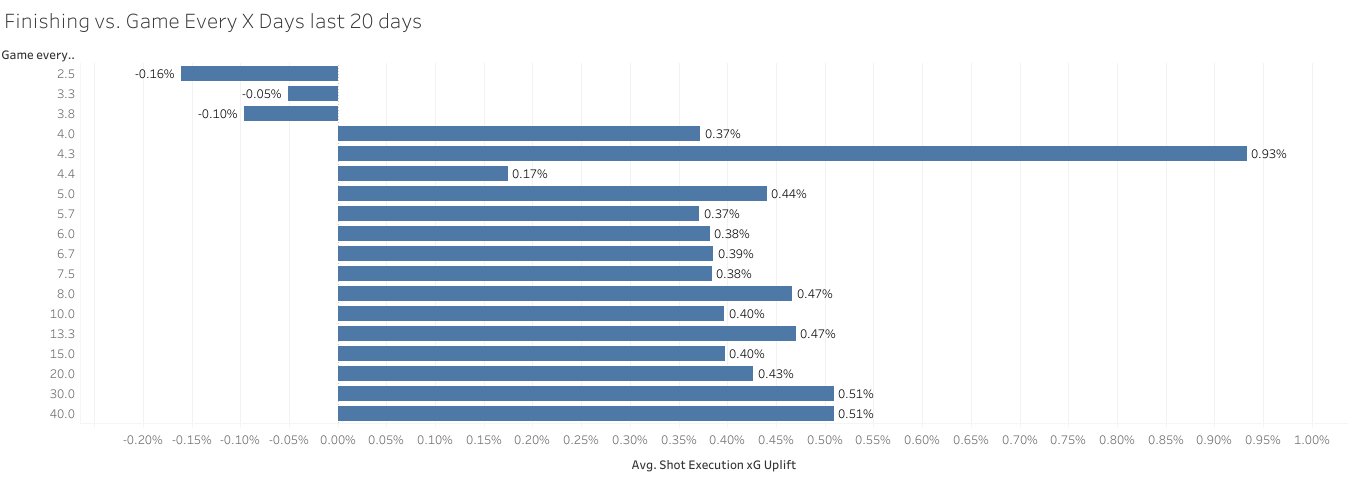The Premise
Having recently started playing a little 11v11 football, one thing that has stuck out is how difficult it is to hit the ball very hard after 50 minutes of sprinting up and down the pitch (highlights here).
I realize you’re rolling your eyes at me comparing myself to elite athletes, but the idea of fatigue affecting certain actions on the pitch is not a new one.
There are plenty of studies (this, this, this) with mixed results that either say A) elite athletes are aliens and fatigue doesn’t affect them a lot or B) it actually does affect them.
More specifically, a few conversations with
(after watching both Arsenal and Liverpool underperform xG badly over the festive period) had me thinking about how to test out this hypothesis.I landed on this:
Using Statsbomb’s shot execution model (post-shot xG minus xG) ((aka how much did the shot add to the chance of a goal)) and several proxies for fatigue to see if we can tease out any effect.
Idea #1: Month as a Proxy for Fatigue
It has always felt like winter is the toughest time where fixtures pile up and the beginning and end of season are better:
Hmm, doesn’t quite workout. July and May and January (?!) are the best finishing months, with March, November and October the worst. August being low also doesn’t make sense.
Perhaps different leagues get different breaks, so match month is too broad
Idea #2: Days Between Games
When teams get more than 5 days rest, they shoot the ball 10% better. That seems like (small) confirmation that fatigue matters, but maybe not terribly when you get some time off.
Two games back to back isn’t really a big load on players though, so perhaps the better way to do is like # of games in last X days:
Now this is interesting!
If you play a game every 2.5 days in the last 10-20 days, you shoot much worse than if you play a game every 10 days in the last 10-20 days!
The cut-off seems to be 4-5 days, although things did get a little funky when I tried to include rolling last 30-40 days instead of 10-20:
Despite some outliers in the 4 bracket (on a small sample size), both seem to point to some sort of relationship existing, as finishing starts getting above average (~0.4%, around 10 days rest)
And if you put them into bins you can see the relationship get stronger:
This is quite promising, especially since teams that play games close together are probably going to rotate. In the future could do this on a player level to get more accuracy.
Idea #3: In-Game Fatigue
Last but not least, I figured it try out if fatigue exists in-game, which seems the most obvious:
This seems the most promising and intuitive, with the first 30 minutes of the game the best, the last 30 minutes the worst, and the half-time break creating a small bump! I’ve excluded substitutes here, as they come in fresh.
Two interesting things stick out when looking at substitutes:
Weirdly, subs follow the same pattern in 2nd half, but generally suck in the first half:
Some of this is small sample size, but also first half subs are probably unplanned and didn’t warm up
The second interesting thing is that substitutes, no matter how fresh, are generally worse than starters, which is A) surprising because they’re fresh and B) not surprising because they’re substitutes for a reason?
Conclusion:
Overall, it seems like we’ve been able to confirm that fatigue does play a small role in ball-striking.
Teams that have games in close succession shoot worse, even when not accounting for rotation.
In game fatigue looks somewhat real (although game state, mental pressure, etc could also play a role)
In the future, more work can be done to flesh this out looking at more load on individual players and adjusting for game-state, skill levels, and mental pressure.
I’m not sure there’s any actionable insight here for analysts and coaches. Get your subs on early doesn’t seem to actually hold true, as fatigued good players seem to shoot better than not fatigued worse ones?













Any thought given to the shot quality/desparation of shots taken in the 90+ segment? I'd imagine a higher volume of worse shots are taken and wonder if that impacts these numbers. Awesome piece